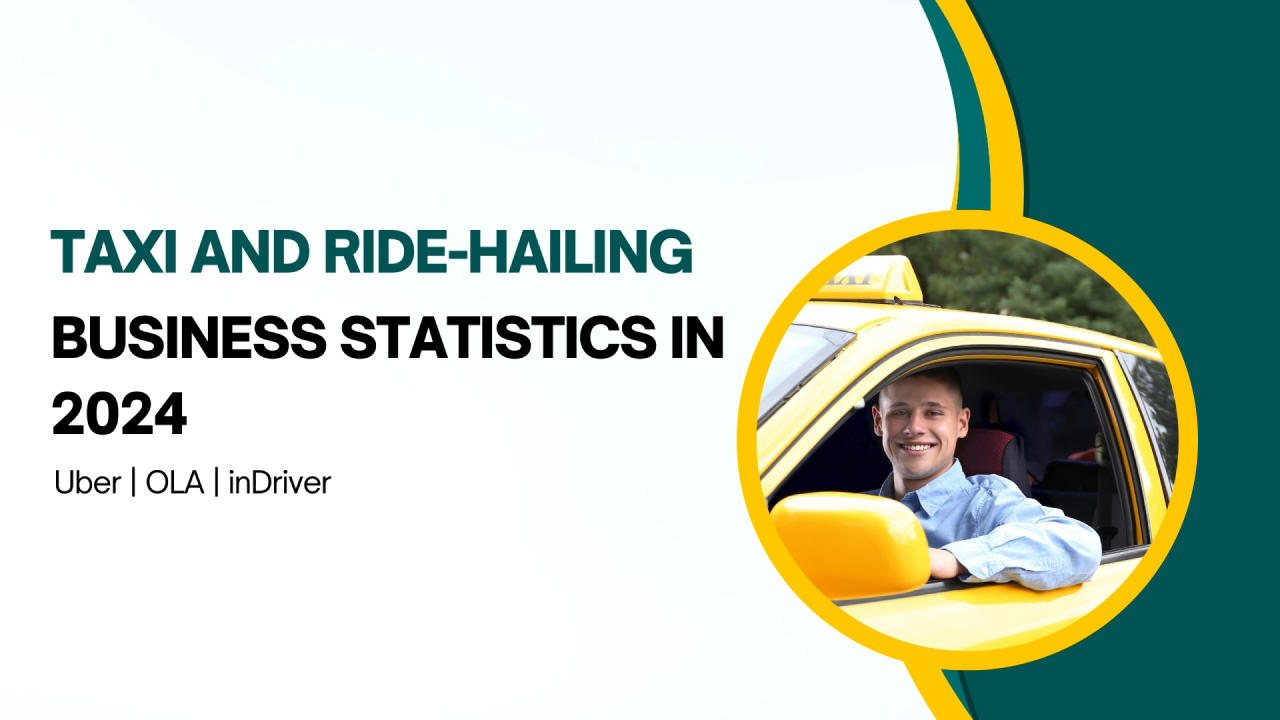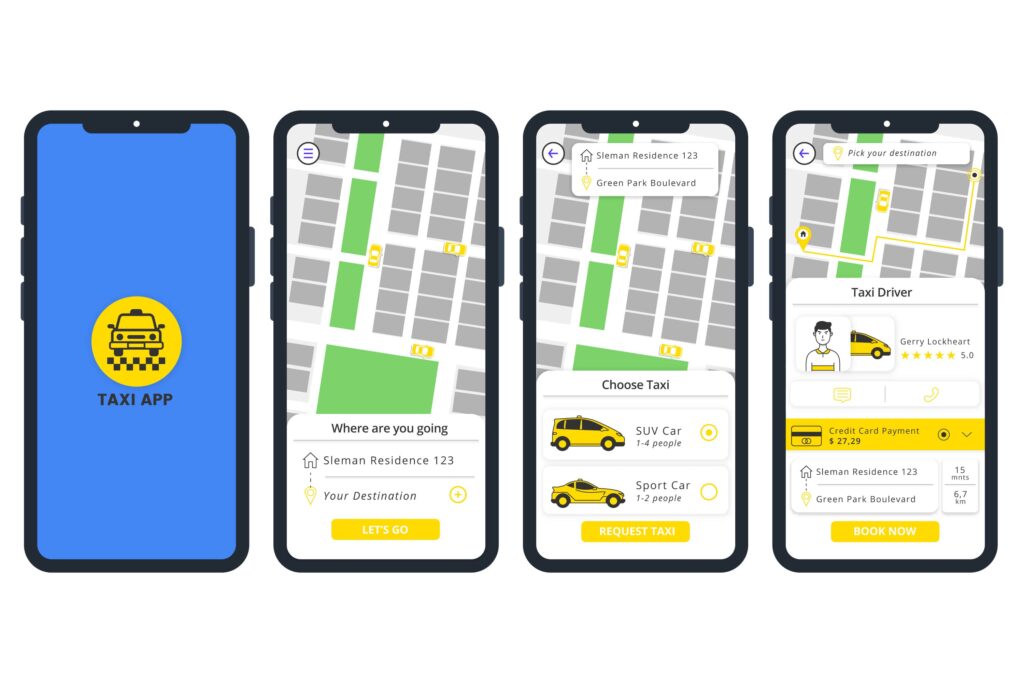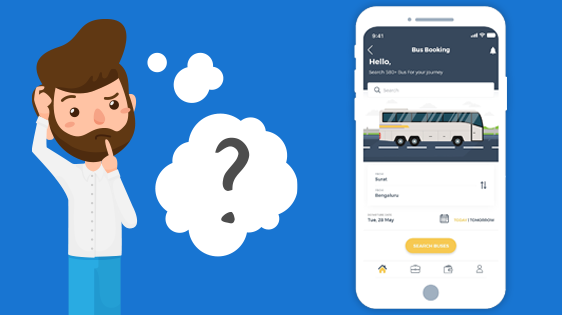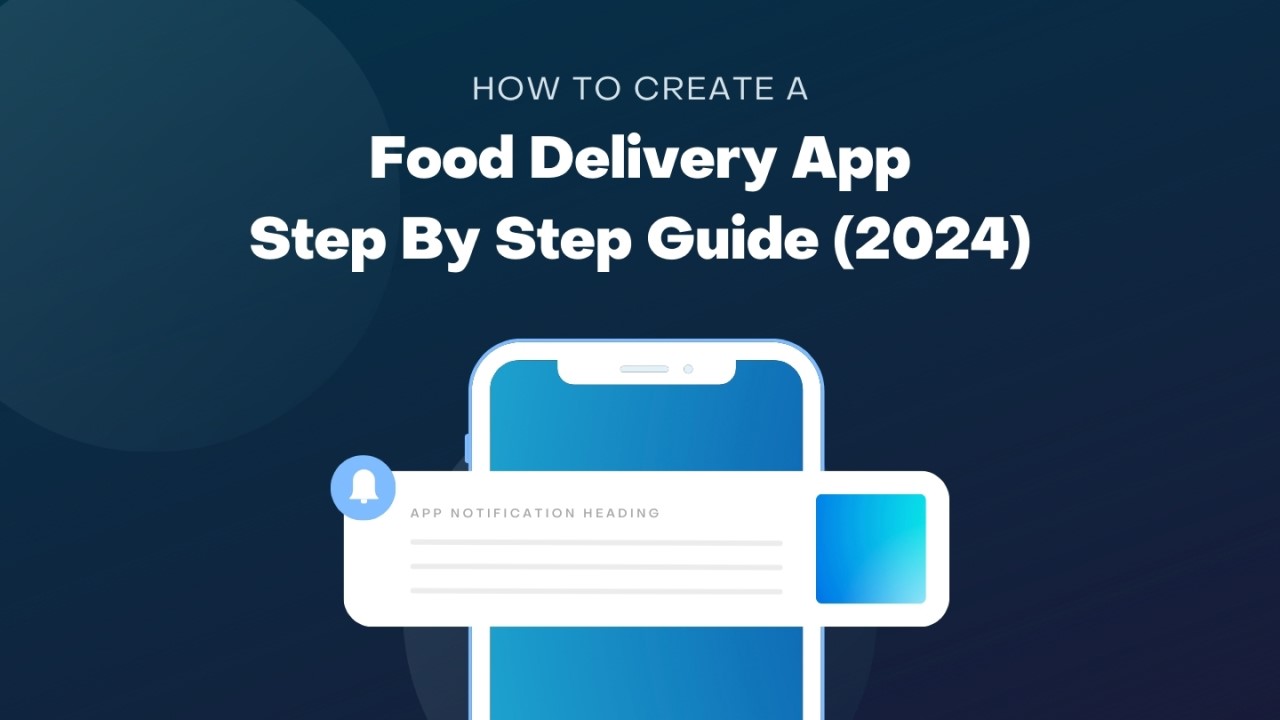Global expansion for transport companies is not easy. They meet geographic differences, which require customized solutions; they meet cultural variations and the very many regulations that vary by country. Technology opens up opportunities in e-commerce and eco-solutions, but these must be changed continuously. Furthermore, growing customer demand for seamless Taxi and ride-hailing experiences and real-time tracking requires advanced approaches. Overcoming the challenges assures reliability, safety, and sustainability for wider reach and success in the dynamic global transport industry. Let’s explore Taxi and ride-hailing app business statistics of Uber, OLA, inDriver and many popular Taxi business and apps. A holistic approach must be addressed to this issue, from technology and infrastructure up to the regulations and strategies that are customer-centric.
Ride-hailing App Industry Statistics 2024
Industry Size:
Global transportation is enormous. The number itself ranges from USD 6.4 trillion to USD 7.3 trillion in 2022. Here’s a breakdown:
- Market size: Most sources place it in 2022 at around USD 7.3 trillion.
- Growth: Most forecasts see the industry grow tremendously and the market forecasts range from a CAGR of 5.4% to 8.11%, reaching as much as USD 11.1 trillion by 2030 or USD 15.94 trillion by 2032.
So the actual size may fluctuate slightly depending on the specific report and methodology, but all the same, it’s a clear leader among global industries.
Industry growth:
Global Transportation Industry currently has steady growth. It is envisioned at approximately $7.3 trillion in the year 2022, and the projection is now envisioned at about $11.1 trillion by the year 2030 with a CAGR coming out close to 5.4%. The growth drivers include urbanization and rising populations. The more people one has in towns, the higher the demand for transport.
Boom in e-commerce: Online shopping means increased demand for delivery networks, boosting the transportation sector.
In fact, road transportation is a market leader today because of the flexibility and reach it provides, but the industry also suffers a paradigm shift in the same moment toward sustainable solutions like electric vehicles, accompanied by greater concern for the environment.
Number of apps:
An exact number for transportation apps globally is elusive. The market is inundated with variances—public transport apps, such as Lyft and Grab, ride-hailing giants, such as Uber and Ola, micro-mobility options, which include bike-sharing, and others for booking trains or buses.
All these categories would likely mean millions of apps for transportation. App stores are not exhaustive. In the case of the other local players, although the giants dominate ride-hailing for public transport, all the small competitors would cater to specific regions. This fragmentation makes it difficult to make a specific count.
Number of business:
It is quite hard to give an approximate number of transportation businesses in the world because the industry is extensive, covering anything from giant corporations such as FedEx to local taxis and rickshaw operators.
We know that employment in the transport sector is huge, variously estimated to be tens of millions worldwide. The sector is also highly fragmented, with estimates suggesting hundreds of thousands of small and medium-sized enterprises in addition to a handful of giants.
The figure here is impossible to say with accuracy, but it is said to be a trillion of the value in the logistics market alone, which gives an idea of how vast a network of businesses keeps the world’s goods and people moving.
Problems Statement:
Global transport companies face multifaceted challenges in expanding their reach to their customers. Geographical diversities come in the way as different geographical regions require tailor-made solutions and infrastructural support. The challenge comes in the form of cultural diversities and regulatory variations, compelled to tread through the regulatory landscape across countries. Technology advances present an opportunity as well as a challenge, requiring adaptability to evolving trends such as e-commerce and environment-friendly transport solutions.
In addition to this, the fact that service delivery and customer engagement with increased expectations from customers for seamless experiences and real-time tracking would necessitate the provision of advanced approaches further makes it complex. Completion of all these challenges is assured reliability, safety, and sustainability amidst increasing demand and further growth in the dynamic global transport industry. All of these multifaceted challenges call for a holistic approach capable of addressing technology, infrastructure, regulatory adherence, and customer-centric strategies toward leading to wider reach and sustainable growth of the transportation industry across the globe.
Solution:
Such applications, developed with a full range of capabilities, would redefine the reach of global transport companies. Real-time tracking, booking, and payment functionalities can improve their convenience and accessibility from anywhere in the world. Localization features and support of multiple languages can break the barriers of culture and language and make it more inclusive. Personalized recommendations, loyalty programs, and such strategies incentivize customer engagement toward brand loyalty and repeat business. Improved communication channels through in-app messaging and customer support features enhance the user experience and satisfy them. Mobile apps break the geographical, cultural, and regulatory barriers of connectivity for transport companies with customers all over the world.
Benefits of Applying the Business Solution in your Taxi and Ride-hailing App
A mobile app is a key ingredient to be at the top of the game for transport businesses today. This is far more than an easy means; it is directly about streamlining processes, increasing efficiency, and enhancing customer experience—translating to a competitive edge for the transport business. Here is how well-designed app solutions can help your transport business:
Increased Efficiency and Productivity:
- Fleet Management:
With the app, keep track of the location and status of your fleet. Optimized route planning and dispatching can all happen seamlessly, thus saving you from idle time and fuel consumption. - Paperless Operations:
Bid adieu to paperwork! Use the app for digital documentation, making the process of record-keeping, order processing, and invoicing easy and efficient. - Data-Driven Decisions:
Keep track of critical performance data related to drivers, routes, and delivery times. Use the data to identify bottlenecks and optimize your operations.
Better Customer Experience:
- Frictionless Booking:
Your customers are at liberty to reserve and monitor their transport from any part of the world with a click of the button. It incorporates instant quotes, online payments, and real-time tracking. - Real-time Updates:
Enable tracking in real-time so that your customers can easily reach you using the in-app chat or messaging. - Customer Feedback Loop:
Gather useful feedback from customers through the application. Leverage this for service improvement and quickly get any customer grievances redressed.
Competitive Advantage:
- Better Visibility:
A well-designed app acts as a digital storefront, making your services visible to new customers. - Differentiation:
Apps can offer unique features that set you apart from your competitors. This could include a loyalty program, special offers, or integration with other platforms. - Better Brand Image:
A user-friendly app puts your business in a modern, tech-savvy, and customer-focused box.
What More?
- Better Driver Management:
Apps can ease your driver communication, assign tasks, and even simplify digital record-keeping of driver logs and documents. - Better Revenue Opportunity:
Through the app, you can offer additional services—for example, premium delivery options or add-on services.
The Right App for Your Business:
The features of your app shall be specific to your niche in the transport industry, be it a taxi service provider, trucking, or logistics. The mentioned benefits are general in nature. Consider your target audience, business goals, and budget while designing your mobile app solution. With a perfectly designed app, you can revolutionize your transport business in terms of efficiency, customer-centricity, and competitiveness in the ever-evolving transportation scenario.
Top Ride-hailing Industry Leaders
Uber:
Popularity of Uber is because of its ubiquity and user friendliness. It has presence in more than 900 metropolitan markets globally. Uber offers several ride options, from economic to premium, and hence it is accessible to almost everybody, and different choices depending on the volume of the preferences and price sensitivity. Uber-ride has made millions of commuters book on its platform because of the ease of booking, real-time tracking, and cashless payment system. Besides, Uber’s constant innovation, by incorporating safety features and diversification into other services such as food delivery, has helped cement its position as the leader in the ride-hailing industry.
Lyft:
Popularity of Lyft is because of its sociability to its community and social responsibility. Lyft focuses on environmental sustainability and driver-friendly policies, and this has helped it attract environmentally conscious users and socially aware consumers. Its offering is at very low prices, and pleasant drivers and its celebrity of inclusivity has helped it develop a loyal user base in the metropolis of the United States and Canada.
Grab:
That Grab has become a fact of life in Southeast Asia is because it has diversified into other services besides ride-hailing: food, parcel delivery, and financial services. It operates in over 400 cities across eight countries. This has turned it into an indispensable part of life for millions in the region. It has been able to take a dominating position in the ride-hailing and super app markets in the region of Southeast Asia through its strategy of rapid expansion, localization process, and customer satisfaction.
Ola:
Ola is popular because it has a deep understanding of the Indian market and all the tailored services that relate to the needs and wants of Indian consumers. From auto-rickshaws to bikes, Ola provides a variety of rides, making it capable of catering to the transportation needs of Indian urbanites. Its low fares, a vast network, and the emphasis on security have contributed to ensuring that Ola is popular among millions of commuters in India. Ola’s consistent innovation, like the introduction of electric vehicles and in-cab entertainment, ensures that it continues to shape the future of mobility in India.
inDrive:
One of the most significant reasons that make inDrive popular in Russia is their commitment to safety, reliability, and transparency. Primarily operating in major cities in Russia, inDrive has gained popularity mainly because of the easy-to-use interface of the app and the fact that it provides an accurate fare estimate. The responsiveness in the customer service in the inDrive app has increased the trust factor among commuters looking for a reliable transport option in Russia. Besides, inDrive’s respectful attitude towards the drivers and the fair compensation has helped them enjoy goodwill and positive reputation among both the riders and the drivers of Russia.
Common features which every ride-hailing app has built-in
The ride-hailing applications include Uber, Lyft, Grab, Ola, and inDrive, portraying exactly what the world has been crying for regarding speed in providing current solutions that make transport within cities a breeze. In fact, the influence of technology in the transport sector has made it look so cool because the services are efficient, affordable, and one can monitor the location in real time. But what’s their secret? Let’s have a look at what major features these popular ride-hailing services have in common.
User Interface (UI) and User Experience (UX):
- Minimalist, user-friendly:
These applications pay massive attention to the user. The registration process, ordering a ride, and managing payments should be convenient even for the very first users. - Interactive Map Integration:
A simple, active map is the very foundation of any ride-hailing app. Users should see nearby available drivers, track the real-time progress of the ride they ordered, and see their route of choice. - Several Ride Options:
All of these services are serving different needs. Multiple ride categories may be available, such as affordable rides, high-class cars, SUVs with more passengers, or motorbike taxis in some parts of the world. - Estimated Fare Display:
Users should have transparency. Estimated fares based on distance, time, and traffic conditions are really necessary for a user to decide whether to order a ride or not.
Booking and Payment:
- Easy Booking Process:
In many cases, these apps require users to simply enter their pick-up and drop-off locations, the type of ride they want to book, and make a booking just with a few taps. - Several Payment Methods:
In the current payment era, modern payment methods are required. Integration with popular digital wallets and credit card processing enables fast and cashless payment. Some apps may even have an in-app wallet solution for storing money. - In-App Offers and Discounts:
Ride-hailing companies usually offer promotions and discounts in order to attract or retain users. These can be featured prominently within the application and, most importantly, implemented at the time of booking.
Safety and Security:
- Driver Verification:
To ensure the passengers’ safety, such apps have ways to verify identities and the background of the drivers before letting them on to the platform. - Real-Time Tracking of the Driver:
For an extra feeling of security, the user can track their driver’s location on the map in real-time to estimate the arrival time. - Emergency Button:
An in-app emergency button can connect directly to emergency services or the ride-hailing company’s safety team in case of an incident. - Trip Sharing:
This feature can be used to increase the safety of the user as they can share the trip details with friends or family so that they can track the ride’s progress and can ensure the safety of their loved one.
Other Features
Two-Way Rating and Review
To maintain a high standard of service and identify areas that need improvement, both passengers and drivers can have a two-way rating and review system.
Communication between Passenger and Driver
For good communication, both passengers and drivers can communicate with each other using the in-app chat function, which can be used to clarify the pick-up location or give special instructions or in case of unexpected delays.
Accessibility Features
To increase accessibility, most apps offer users with disabilities voice-activated booking or get connected with accessibility services like screen readers.
These are but a few of the common features that made ride-hailing apps such as Uber, Lyft, Grab, Ola, and inDrive part of those changing the urban landscape of mobility. They have been focusing on user experience, transparency, safety, and varied ways of riding. This makes hundreds of millions of users around the world get a very convenient and reachable transport solution. And as technology keeps on advancing, new features are definitely bound to come in. That will help improve the experience of a trip not only for passengers, but for drivers too.
Unique Features
While Uber, Lyft, Grab, Ola, and inDrive do share many core features, each app offers unique functionalities that cater to specific markets and user preferences. Here’s a glimpse at what makes them stand apart from one another ride-hailing app:
Uber:
- Uber Rewards:
A loyalty program rewarding frequent riders with points redeemable for free rides, upgrades, and other perks. - Uber Eats Integration:
Seamless integration with Uber Eats allows users to order food delivery alongside booking a ride, creating a convenient one-stop platform. - Uber Green:
An eco-conscious option that connects riders with drivers using hybrid or electric vehicles, promoting sustainability.
Lyft:
- Shared Rides:
Lyft offers shared ride options, allowing passengers to share their ride and save money by splitting the fare with others traveling a similar route. - Round Up & Donate:
A charitable feature that allows users to round up their ride fare to the nearest dollar, with the difference being donated to a chosen charity. - Tipping Options:
Lyft prominently displays tipping options within the app, making it easier for passengers to show appreciation to their drivers.
Grab:
- GrabPay:
A built-in digital wallet for cashless transactions within the Grab ecosystem. This can be used for ride-hailing, food delivery, and other Grab services. - GrabBenefits:
A loyalty program that offers users discounts and rewards across various partner merchants, extending the benefits beyond just ride-hailing. - GrabHitch:
Similar to Lyft’s shared rides, GrabHitch allows users to carpool with others for a cheaper fare, promoting ridesharing and reducing congestion.
Ola:
- Quick Ride Mode:
A unique feature in India, Ola Quick Ride Mode prioritizes faster pick-ups by connecting users with the nearest available driver, ideal for short-distance trips. - Ride Later Bookings:
Schedule rides in advance with Ola for airport pickups, important meetings, or any situation requiring a guaranteed ride at a specific time. - Cash on Delivery:
Ola accommodates the people who do not have digital wallets or credit cards by providing an option to pay cash at the end of the ride.
inDrive:
- Real-time Price Negotiation:
inDrive allows its passengers to give a suggested price for a ride and negotiate directly with the drivers, making it a dynamic pricing model. - Multi-Stop Option:
The passenger can arrange trips with multiple stops in the inDrive app. This helps in optimizing errands and deliveries in a single ride. - Driver Ratings on Negotiation of Price:
inDrive rates the driver based on how much space and reasonableness is shown by the driver in negotiating the fare, working to encourage fair and equal pricing for both parties.
These unique features demonstrate that ride-hailing companies are continuously innovating to be able to attract users and to further differentiate themselves in the market. In meeting some specific needs and preferences, these apps try to provide the most convenient, cost-effective, and user-friendly transportation experience possible.
Revenue Models
Yet these firms rake in the tens of millions without owning a single car or employing a single driver. How then do these ride-hailing apps make money from rides?
- Commission on Fares:
The core revenue model is to cut out a percentage from each fare made by the passenger, in the region of 20-35%. This encourages the app to ensure the riders and drivers remain in its ecosystem. - Surge Pricing:
In high-demand times, like peak hours, when there are high demands for the service, these apps reserve the right to increase the fare. This is for the purpose of keeping drivers always available and increasing the revenue stream. - Cancellation Fees:
Often, the apps may charge a penalty to the passenger that should act as a deterrent for the passenger not to cancel at the last minute. - Premium Services:
Some apps have exclusive riding services, such as luxury cars or faster pick-ups, which call for an extra payment. This means increased revenue streams for the app company. - Monetization:
One can develop revenue sources with targeted in-app advertising, but this should be done cautiously so that it does not become clutter for the user. The combination of all these models is harvested together to make an app. Where passengers get to enjoy an easy ride, drivers get a means of making a living, and the app company intermediates the transaction and gets a piece of the value.
How much does it cost to develop a Taxi booking app in 2024?
Developing a ride-hailing app can cost from $8,000 to $15,000 for a basic version. This is a rough estimate. The final cost can vary wildly based on a variety of factors:
- Features and Complexity:
More features, such as real-time fare negotiation or multi-stop options, cost more in development. - Development Platform:
More you build a native app for both iOS and Android, the more expensive development gets. Think of cross-platform development to balance cost and reach. - Developer Location:
Paying developers in regions where hourly rates are low can help lower the overall cost.
Beyond the Initial Investment:
This is the initial investment, and it’s just the tip of the iceberg. Ongoing maintenance, server upkeep, and updates for future features will cost more.
Bootstrapping on a Shoestring:
If you are low on funds, then build a minimum viable product—a lean mean version only with the core functionalities and nothing more. You can test the market and then attract investors and funding for further development based on user feedback.
Why are we the most suitable company for this ride-hailing app solutions?
Building a successful ride-hailing app requires a development partner who knows the industry, has the technical capabilities, and does not take away your vision. Here is why The App Ideas is the best company to take your app to the next level:
Deep Industry Knowledge:
We, at The App Ideas, tend to follow the latest trends and innovations within the ride-hailing industry. Our developers are aware of the core functionalities, unique features, and revenue models necessary to make an app successful in this field. This helps translate your concept into an app tailored to your target market and able to compete in the market.
Technical Skills and Experience:
Our team consists of experienced mobile app developers who have dealt with the complexities of real-time mapping, location services, secure payment integration, and two-way communication features that are vital to the ride-hailing app. We also have experience in native development (iOS and Android) and cross-platform development, so we will find a most cost-effective solution for you.
Focus on UX:
We will provide the user interface of ride-hailing applications with the user-friendly and intuitive factor. Our design team will create a clean and user-centric application that is easy to navigate for both riders and drivers. This focus on UX will help contribute to high user adoption and positive user reviews, which are the key success factors for an application.
Collaborative Approach:
We will also take a collaborative approach with our clients. We will keep the lines of communication open with you during the development process, pay attention to your feedback, and keep you updated at every stage of the development. The solution that we shall deliver will be the one that shall be consistent with your vision and business objectives.
Competitive Pricing and Scalable Solutions:
We shall provide you with competitive rates on the development of the application. And we design scalable solutions that can accommodate future growth and additional features. This ensures that the app can grow with the changing market demands and the needs of users. With The App Ideas, you’re a one-stop-shop for an industry-based know-how, technical prowess, and a user-centric approach to realize your ride-hailing app vision. Along, we can make a transportation solution that will change how people travel in your target market.
Do you have any of ideas for starting a business with the same? Let’s connect with The App Ideas!
FAQs
Why partner with The App Ideas to develop a ride-hailing app?
Our development team has gained experience in the ride-hailing application business with technical support to develop efficient and easy-to-use mobile applications. It is focused on user experience, and the collaboration with the client is active. The cost of the app’s development is competitive, and we develop scaled applications.
How much will a ride-hailing app cost me?
The entry-level version of the ride-hailing app will be cost-effectively made at a price from $8,000 to $15,000. Each feature, as well as the choice of the platform, will define the price. We will determine the most price-effective option to onboard you.
What features can I add to my ride-hailing app?
The core features of ride-hailing—such as real-time mapping, fare calculation, and safe in-app payments—will be integrated into our application. Further, we will develop a unique feature—such as surge pricing, multiple stops, or an in-app chat—based on your requirements.
My app will be on both the iOS and Android?
Our team has experience with native mobile development but also has the capabilities for cross-platform development. We will guide you to the best solution based on your target population and your budget.
What happens after the launch of my app?
We offer post-app-launch maintenance, server maintenance, and future feature improvements to ensure smooth operating of the application and adherence to market trends.























